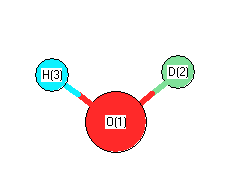Geometric Data

Point Group Cs
Internal coordinates
distances (r) in Å, angles (a) in degrees, dihedrals (d) in degrees
| Description |
Value |
unc. |
Connectivity |
Reference |
Comment |
| Atom 1 |
Atom 2 |
Atom 3 |
Atom 4 |
Cartesians
| Atom |
x (Å) |
y (Å) |
z (Å) |
| O1 |
0.0000 |
0.0000 |
0.0000 |
| H2 |
0.0000 |
0.7595 |
0.5807 |
| H3 |
0.0000 |
-0.7595 |
0.5807 |
Atom - Atom Distances 
Distances in Å
| |
O1 |
H2 |
H3 |
| O1 |
|
0.9560 | 0.9560 |
| H2 |
0.9560 |
|
1.5189 |
| H3 |
0.9560 | 1.5189 |
|
Calculated geometries
for HDO (Water-d1).
Experimental Bond Angles (degrees) from cartesians 
| atom1 |
atom2 |
atom3 |
angle |
| H2 |
O1 |
H3 |
105.200 |
Bond descriptions
Examples: C-C single bond, C=C, double bond, C#C triple bond, C:C aromatic bond
| Bond Type |
Count |
| H-O |
1 |
| D-O |
1 |
Connectivity
| Atom 1 |
Atom 2 |
| O1 |
H2 |
| O1 |
H3 |











